The European Union and the Euro Crisis: An Institutional Analysis
VerifiedAdded on 2023/06/03
|13
|3650
|208
Essay
AI Summary
This essay provides an analysis of the European Union and the Euro crisis, examining the institutional and structural problems that contributed to the economic turmoil. The paper begins by outlining the origins and development of the EU, including the establishment of the European Coal and Steel Community and the Maastricht Treaty, which introduced the Euro. The essay argues that monetary challenges and dissolute financial transactions within the EU led to the Euro crisis. It explores the historical context of the EU, highlighting its role in promoting peace and prosperity, while also acknowledging recent challenges. The essay discusses the establishment of the Economic and Monetary Union (EMU), the role of the European Central Bank, and the impact of profligate lending and borrowing, particularly in Greece, Spain, Portugal, and Ireland. It examines the structural dilemmas of operating a single currency with multiple varieties of capitalism, the limitations of the Stability and Growth Pact, and the impact of monetary union on growth paths. The essay further explores the deficiency of governing capacities, tax evasion, and the new liberal growth model. The essay concludes by emphasizing the crisis of the European project and the importance of addressing these issues to ensure the stability and future of the EU.
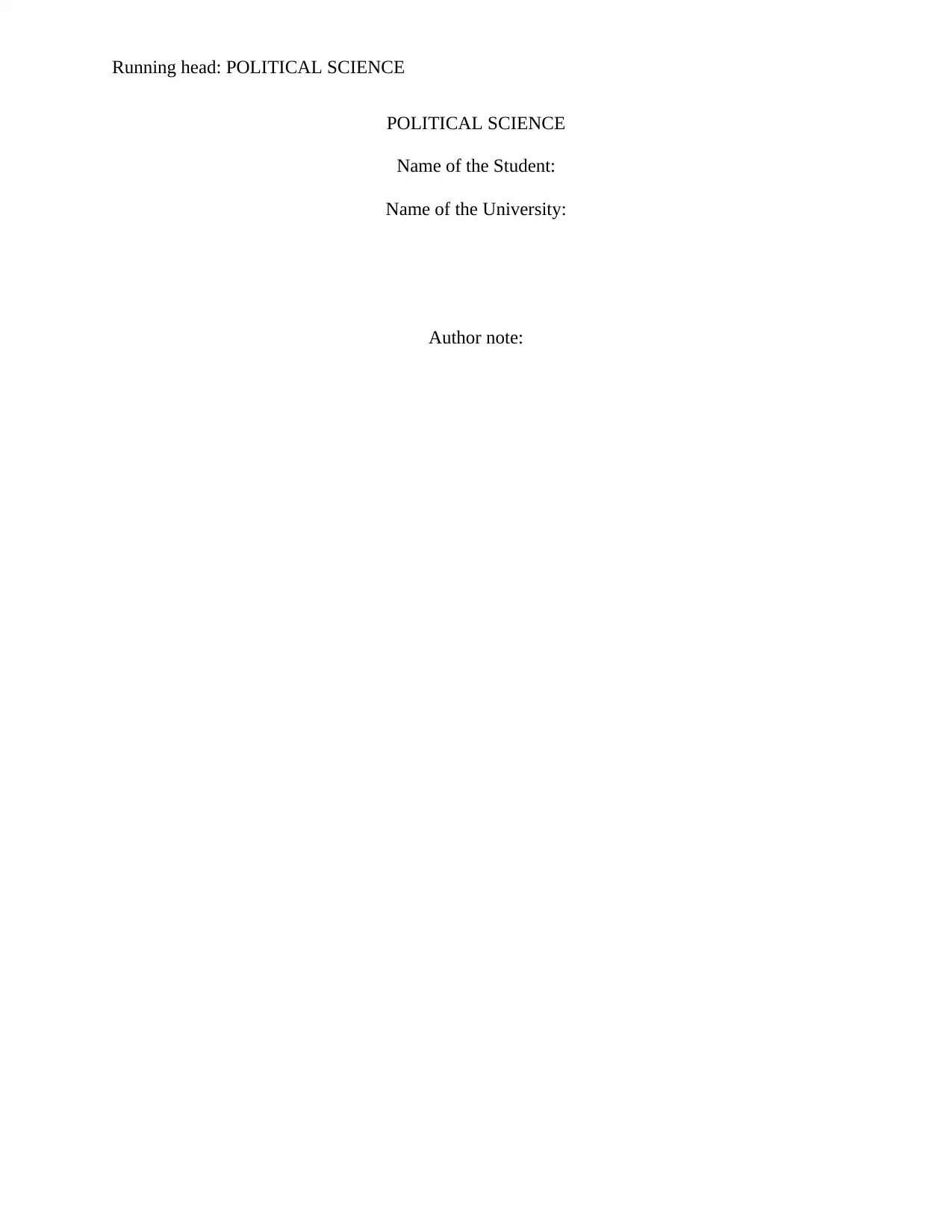
Running head: POLITICAL SCIENCE
POLITICAL SCIENCE
Name of the Student:
Name of the University:
Author note:
POLITICAL SCIENCE
Name of the Student:
Name of the University:
Author note:
Paraphrase This Document
Need a fresh take? Get an instant paraphrase of this document with our AI Paraphraser
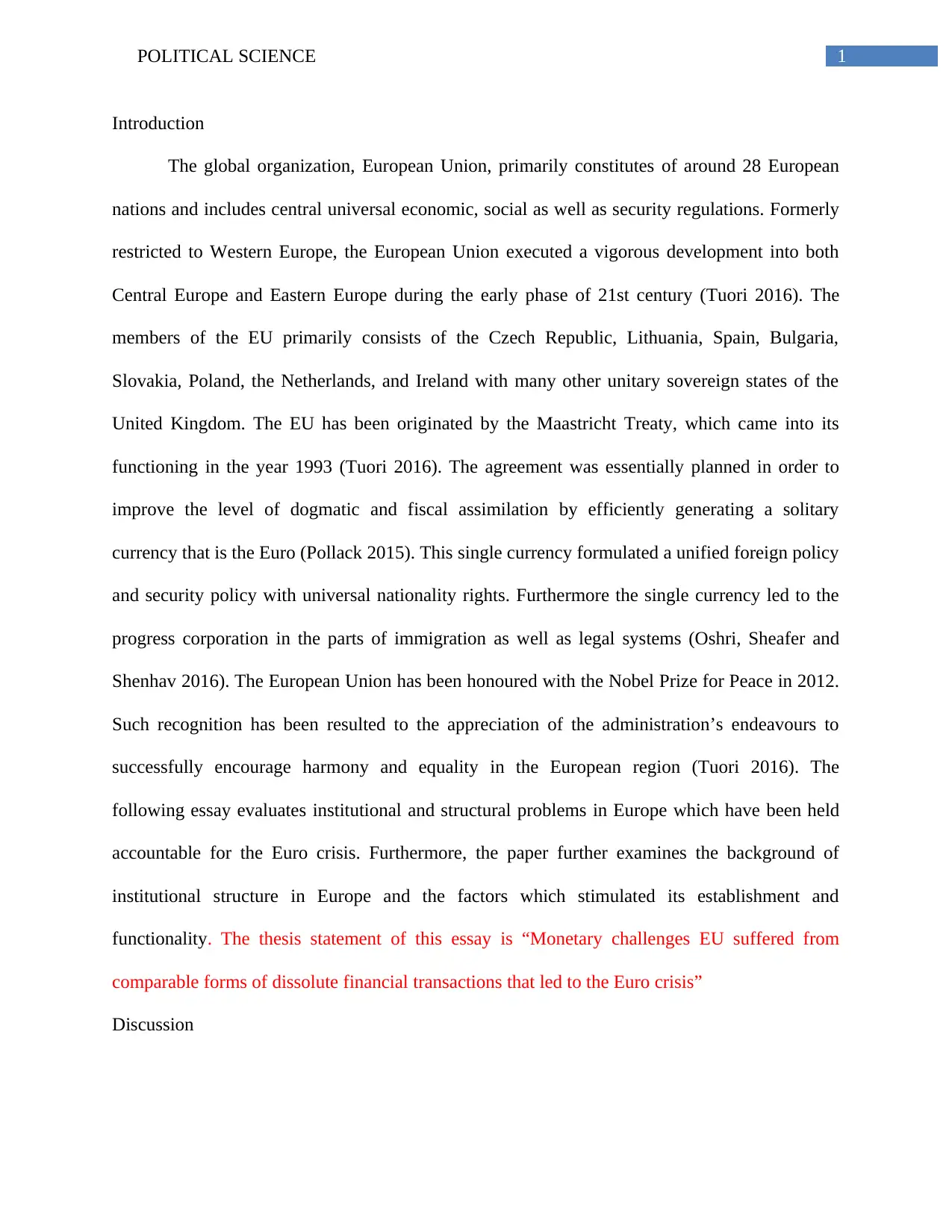
1POLITICAL SCIENCE
Introduction
The global organization, European Union, primarily constitutes of around 28 European
nations and includes central universal economic, social as well as security regulations. Formerly
restricted to Western Europe, the European Union executed a vigorous development into both
Central Europe and Eastern Europe during the early phase of 21st century (Tuori 2016). The
members of the EU primarily consists of the Czech Republic, Lithuania, Spain, Bulgaria,
Slovakia, Poland, the Netherlands, and Ireland with many other unitary sovereign states of the
United Kingdom. The EU has been originated by the Maastricht Treaty, which came into its
functioning in the year 1993 (Tuori 2016). The agreement was essentially planned in order to
improve the level of dogmatic and fiscal assimilation by efficiently generating a solitary
currency that is the Euro (Pollack 2015). This single currency formulated a unified foreign policy
and security policy with universal nationality rights. Furthermore the single currency led to the
progress corporation in the parts of immigration as well as legal systems (Oshri, Sheafer and
Shenhav 2016). The European Union has been honoured with the Nobel Prize for Peace in 2012.
Such recognition has been resulted to the appreciation of the administration’s endeavours to
successfully encourage harmony and equality in the European region (Tuori 2016). The
following essay evaluates institutional and structural problems in Europe which have been held
accountable for the Euro crisis. Furthermore, the paper further examines the background of
institutional structure in Europe and the factors which stimulated its establishment and
functionality. The thesis statement of this essay is “Monetary challenges EU suffered from
comparable forms of dissolute financial transactions that led to the Euro crisis”
Discussion
Introduction
The global organization, European Union, primarily constitutes of around 28 European
nations and includes central universal economic, social as well as security regulations. Formerly
restricted to Western Europe, the European Union executed a vigorous development into both
Central Europe and Eastern Europe during the early phase of 21st century (Tuori 2016). The
members of the EU primarily consists of the Czech Republic, Lithuania, Spain, Bulgaria,
Slovakia, Poland, the Netherlands, and Ireland with many other unitary sovereign states of the
United Kingdom. The EU has been originated by the Maastricht Treaty, which came into its
functioning in the year 1993 (Tuori 2016). The agreement was essentially planned in order to
improve the level of dogmatic and fiscal assimilation by efficiently generating a solitary
currency that is the Euro (Pollack 2015). This single currency formulated a unified foreign policy
and security policy with universal nationality rights. Furthermore the single currency led to the
progress corporation in the parts of immigration as well as legal systems (Oshri, Sheafer and
Shenhav 2016). The European Union has been honoured with the Nobel Prize for Peace in 2012.
Such recognition has been resulted to the appreciation of the administration’s endeavours to
successfully encourage harmony and equality in the European region (Tuori 2016). The
following essay evaluates institutional and structural problems in Europe which have been held
accountable for the Euro crisis. Furthermore, the paper further examines the background of
institutional structure in Europe and the factors which stimulated its establishment and
functionality. The thesis statement of this essay is “Monetary challenges EU suffered from
comparable forms of dissolute financial transactions that led to the Euro crisis”
Discussion
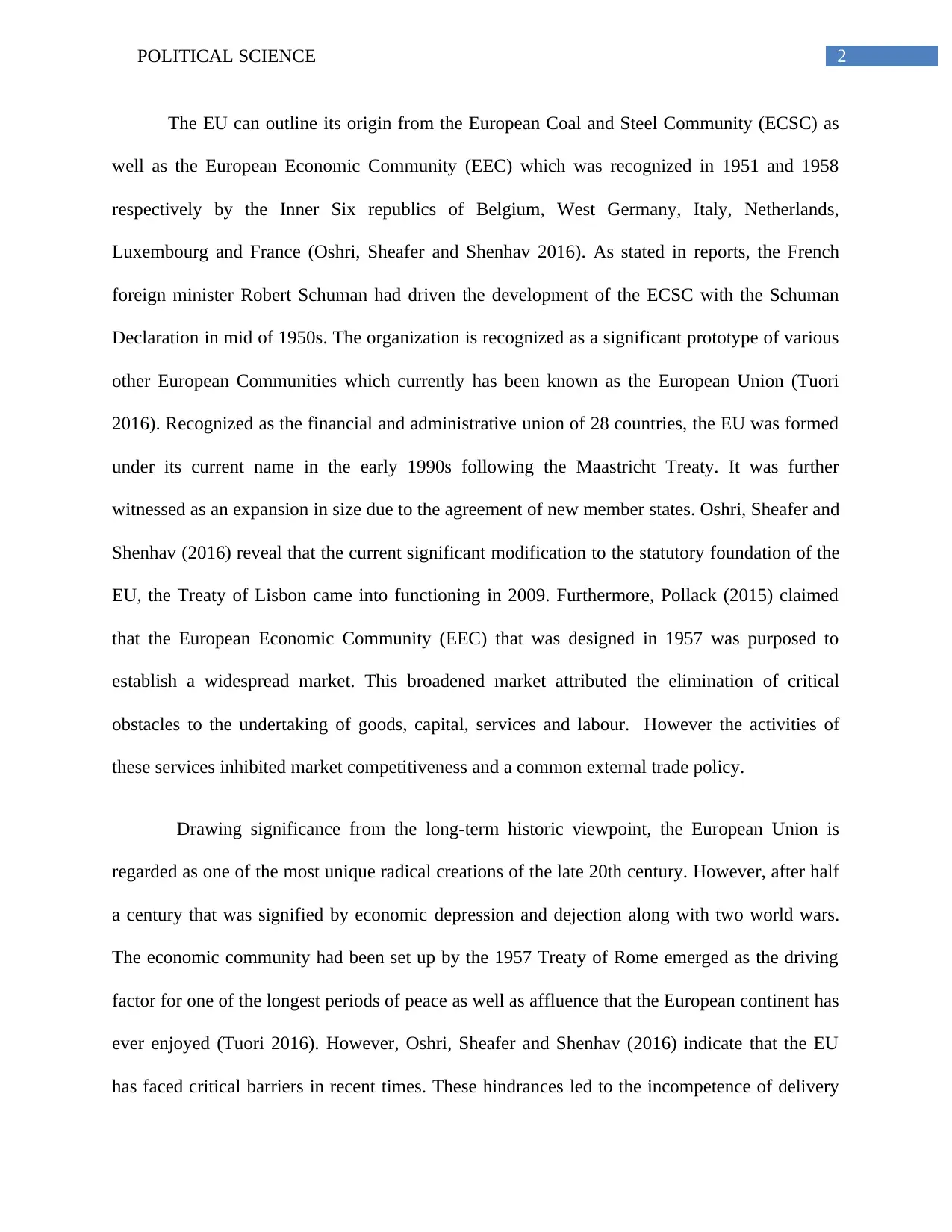
2POLITICAL SCIENCE
The EU can outline its origin from the European Coal and Steel Community (ECSC) as
well as the European Economic Community (EEC) which was recognized in 1951 and 1958
respectively by the Inner Six republics of Belgium, West Germany, Italy, Netherlands,
Luxembourg and France (Oshri, Sheafer and Shenhav 2016). As stated in reports, the French
foreign minister Robert Schuman had driven the development of the ECSC with the Schuman
Declaration in mid of 1950s. The organization is recognized as a significant prototype of various
other European Communities which currently has been known as the European Union (Tuori
2016). Recognized as the financial and administrative union of 28 countries, the EU was formed
under its current name in the early 1990s following the Maastricht Treaty. It was further
witnessed as an expansion in size due to the agreement of new member states. Oshri, Sheafer and
Shenhav (2016) reveal that the current significant modification to the statutory foundation of the
EU, the Treaty of Lisbon came into functioning in 2009. Furthermore, Pollack (2015) claimed
that the European Economic Community (EEC) that was designed in 1957 was purposed to
establish a widespread market. This broadened market attributed the elimination of critical
obstacles to the undertaking of goods, capital, services and labour. However the activities of
these services inhibited market competitiveness and a common external trade policy.
Drawing significance from the long-term historic viewpoint, the European Union is
regarded as one of the most unique radical creations of the late 20th century. However, after half
a century that was signified by economic depression and dejection along with two world wars.
The economic community had been set up by the 1957 Treaty of Rome emerged as the driving
factor for one of the longest periods of peace as well as affluence that the European continent has
ever enjoyed (Tuori 2016). However, Oshri, Sheafer and Shenhav (2016) indicate that the EU
has faced critical barriers in recent times. These hindrances led to the incompetence of delivery
The EU can outline its origin from the European Coal and Steel Community (ECSC) as
well as the European Economic Community (EEC) which was recognized in 1951 and 1958
respectively by the Inner Six republics of Belgium, West Germany, Italy, Netherlands,
Luxembourg and France (Oshri, Sheafer and Shenhav 2016). As stated in reports, the French
foreign minister Robert Schuman had driven the development of the ECSC with the Schuman
Declaration in mid of 1950s. The organization is recognized as a significant prototype of various
other European Communities which currently has been known as the European Union (Tuori
2016). Recognized as the financial and administrative union of 28 countries, the EU was formed
under its current name in the early 1990s following the Maastricht Treaty. It was further
witnessed as an expansion in size due to the agreement of new member states. Oshri, Sheafer and
Shenhav (2016) reveal that the current significant modification to the statutory foundation of the
EU, the Treaty of Lisbon came into functioning in 2009. Furthermore, Pollack (2015) claimed
that the European Economic Community (EEC) that was designed in 1957 was purposed to
establish a widespread market. This broadened market attributed the elimination of critical
obstacles to the undertaking of goods, capital, services and labour. However the activities of
these services inhibited market competitiveness and a common external trade policy.
Drawing significance from the long-term historic viewpoint, the European Union is
regarded as one of the most unique radical creations of the late 20th century. However, after half
a century that was signified by economic depression and dejection along with two world wars.
The economic community had been set up by the 1957 Treaty of Rome emerged as the driving
factor for one of the longest periods of peace as well as affluence that the European continent has
ever enjoyed (Tuori 2016). However, Oshri, Sheafer and Shenhav (2016) indicate that the EU
has faced critical barriers in recent times. These hindrances led to the incompetence of delivery
⊘ This is a preview!⊘
Do you want full access?
Subscribe today to unlock all pages.

Trusted by 1+ million students worldwide
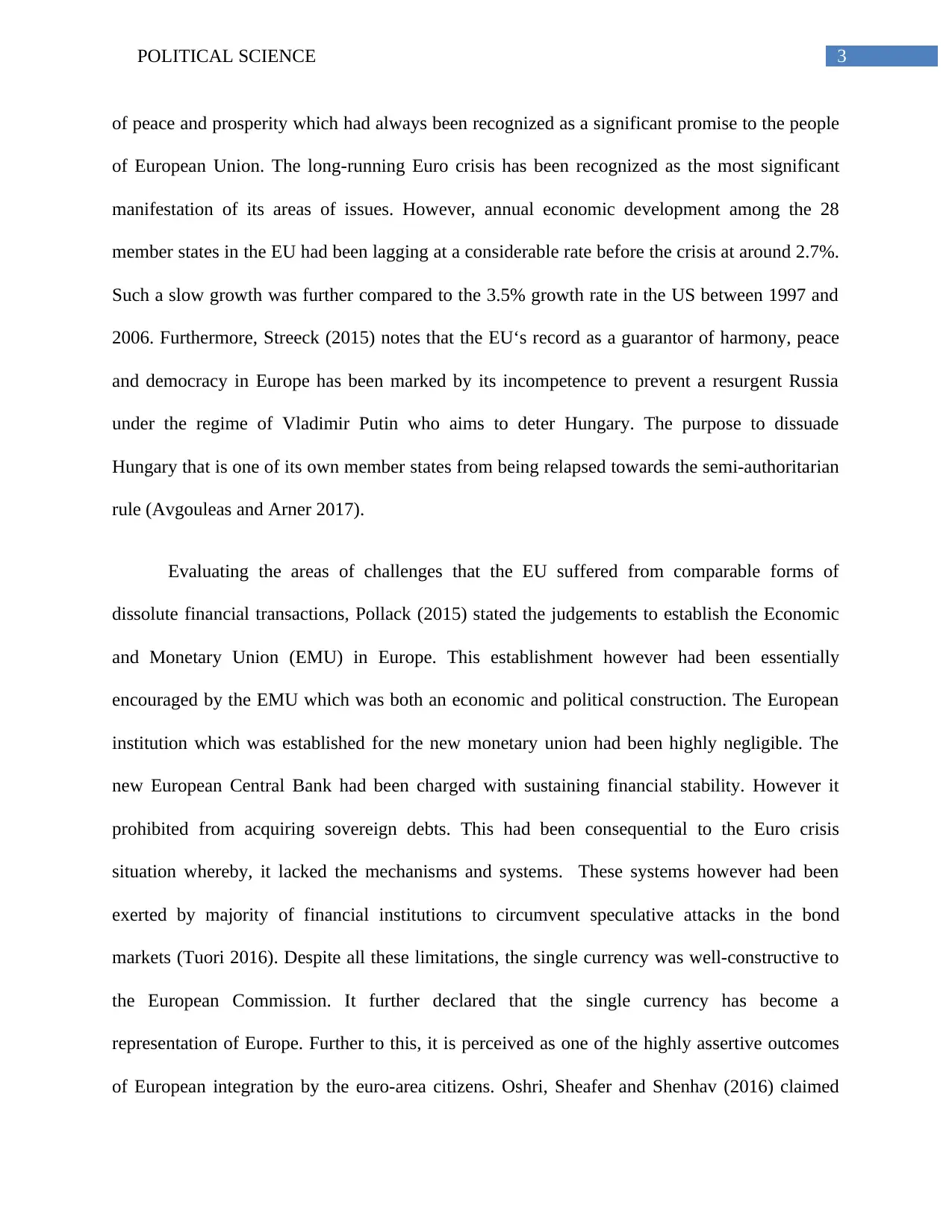
3POLITICAL SCIENCE
of peace and prosperity which had always been recognized as a significant promise to the people
of European Union. The long-running Euro crisis has been recognized as the most significant
manifestation of its areas of issues. However, annual economic development among the 28
member states in the EU had been lagging at a considerable rate before the crisis at around 2.7%.
Such a slow growth was further compared to the 3.5% growth rate in the US between 1997 and
2006. Furthermore, Streeck (2015) notes that the EU‘s record as a guarantor of harmony, peace
and democracy in Europe has been marked by its incompetence to prevent a resurgent Russia
under the regime of Vladimir Putin who aims to deter Hungary. The purpose to dissuade
Hungary that is one of its own member states from being relapsed towards the semi-authoritarian
rule (Avgouleas and Arner 2017).
Evaluating the areas of challenges that the EU suffered from comparable forms of
dissolute financial transactions, Pollack (2015) stated the judgements to establish the Economic
and Monetary Union (EMU) in Europe. This establishment however had been essentially
encouraged by the EMU which was both an economic and political construction. The European
institution which was established for the new monetary union had been highly negligible. The
new European Central Bank had been charged with sustaining financial stability. However it
prohibited from acquiring sovereign debts. This had been consequential to the Euro crisis
situation whereby, it lacked the mechanisms and systems. These systems however had been
exerted by majority of financial institutions to circumvent speculative attacks in the bond
markets (Tuori 2016). Despite all these limitations, the single currency was well-constructive to
the European Commission. It further declared that the single currency has become a
representation of Europe. Further to this, it is perceived as one of the highly assertive outcomes
of European integration by the euro-area citizens. Oshri, Sheafer and Shenhav (2016) claimed
of peace and prosperity which had always been recognized as a significant promise to the people
of European Union. The long-running Euro crisis has been recognized as the most significant
manifestation of its areas of issues. However, annual economic development among the 28
member states in the EU had been lagging at a considerable rate before the crisis at around 2.7%.
Such a slow growth was further compared to the 3.5% growth rate in the US between 1997 and
2006. Furthermore, Streeck (2015) notes that the EU‘s record as a guarantor of harmony, peace
and democracy in Europe has been marked by its incompetence to prevent a resurgent Russia
under the regime of Vladimir Putin who aims to deter Hungary. The purpose to dissuade
Hungary that is one of its own member states from being relapsed towards the semi-authoritarian
rule (Avgouleas and Arner 2017).
Evaluating the areas of challenges that the EU suffered from comparable forms of
dissolute financial transactions, Pollack (2015) stated the judgements to establish the Economic
and Monetary Union (EMU) in Europe. This establishment however had been essentially
encouraged by the EMU which was both an economic and political construction. The European
institution which was established for the new monetary union had been highly negligible. The
new European Central Bank had been charged with sustaining financial stability. However it
prohibited from acquiring sovereign debts. This had been consequential to the Euro crisis
situation whereby, it lacked the mechanisms and systems. These systems however had been
exerted by majority of financial institutions to circumvent speculative attacks in the bond
markets (Tuori 2016). Despite all these limitations, the single currency was well-constructive to
the European Commission. It further declared that the single currency has become a
representation of Europe. Further to this, it is perceived as one of the highly assertive outcomes
of European integration by the euro-area citizens. Oshri, Sheafer and Shenhav (2016) claimed
Paraphrase This Document
Need a fresh take? Get an instant paraphrase of this document with our AI Paraphraser
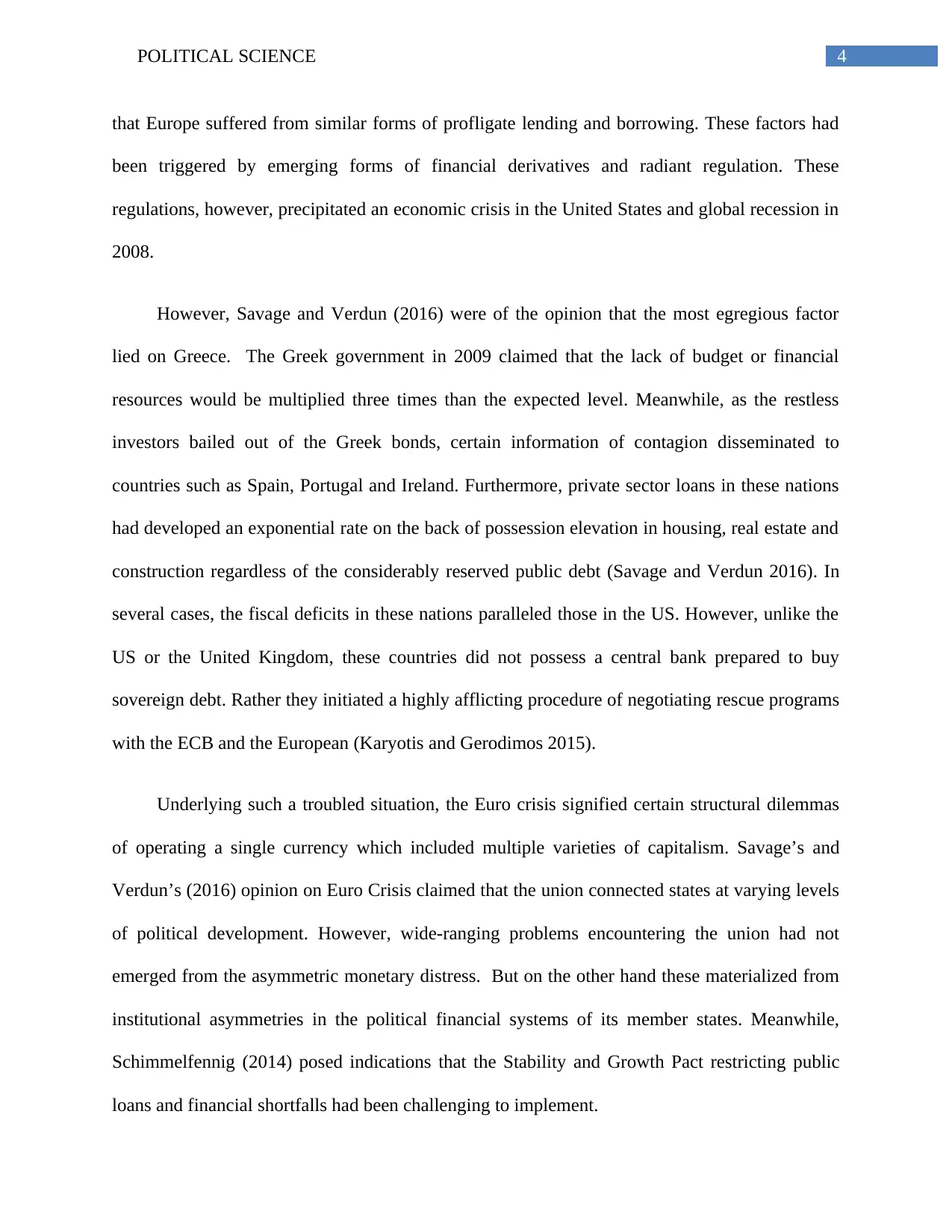
4POLITICAL SCIENCE
that Europe suffered from similar forms of profligate lending and borrowing. These factors had
been triggered by emerging forms of financial derivatives and radiant regulation. These
regulations, however, precipitated an economic crisis in the United States and global recession in
2008.
However, Savage and Verdun (2016) were of the opinion that the most egregious factor
lied on Greece. The Greek government in 2009 claimed that the lack of budget or financial
resources would be multiplied three times than the expected level. Meanwhile, as the restless
investors bailed out of the Greek bonds, certain information of contagion disseminated to
countries such as Spain, Portugal and Ireland. Furthermore, private sector loans in these nations
had developed an exponential rate on the back of possession elevation in housing, real estate and
construction regardless of the considerably reserved public debt (Savage and Verdun 2016). In
several cases, the fiscal deficits in these nations paralleled those in the US. However, unlike the
US or the United Kingdom, these countries did not possess a central bank prepared to buy
sovereign debt. Rather they initiated a highly afflicting procedure of negotiating rescue programs
with the ECB and the European (Karyotis and Gerodimos 2015).
Underlying such a troubled situation, the Euro crisis signified certain structural dilemmas
of operating a single currency which included multiple varieties of capitalism. Savage’s and
Verdun’s (2016) opinion on Euro Crisis claimed that the union connected states at varying levels
of political development. However, wide-ranging problems encountering the union had not
emerged from the asymmetric monetary distress. But on the other hand these materialized from
institutional asymmetries in the political financial systems of its member states. Meanwhile,
Schimmelfennig (2014) posed indications that the Stability and Growth Pact restricting public
loans and financial shortfalls had been challenging to implement.
that Europe suffered from similar forms of profligate lending and borrowing. These factors had
been triggered by emerging forms of financial derivatives and radiant regulation. These
regulations, however, precipitated an economic crisis in the United States and global recession in
2008.
However, Savage and Verdun (2016) were of the opinion that the most egregious factor
lied on Greece. The Greek government in 2009 claimed that the lack of budget or financial
resources would be multiplied three times than the expected level. Meanwhile, as the restless
investors bailed out of the Greek bonds, certain information of contagion disseminated to
countries such as Spain, Portugal and Ireland. Furthermore, private sector loans in these nations
had developed an exponential rate on the back of possession elevation in housing, real estate and
construction regardless of the considerably reserved public debt (Savage and Verdun 2016). In
several cases, the fiscal deficits in these nations paralleled those in the US. However, unlike the
US or the United Kingdom, these countries did not possess a central bank prepared to buy
sovereign debt. Rather they initiated a highly afflicting procedure of negotiating rescue programs
with the ECB and the European (Karyotis and Gerodimos 2015).
Underlying such a troubled situation, the Euro crisis signified certain structural dilemmas
of operating a single currency which included multiple varieties of capitalism. Savage’s and
Verdun’s (2016) opinion on Euro Crisis claimed that the union connected states at varying levels
of political development. However, wide-ranging problems encountering the union had not
emerged from the asymmetric monetary distress. But on the other hand these materialized from
institutional asymmetries in the political financial systems of its member states. Meanwhile,
Schimmelfennig (2014) posed indications that the Stability and Growth Pact restricting public
loans and financial shortfalls had been challenging to implement.
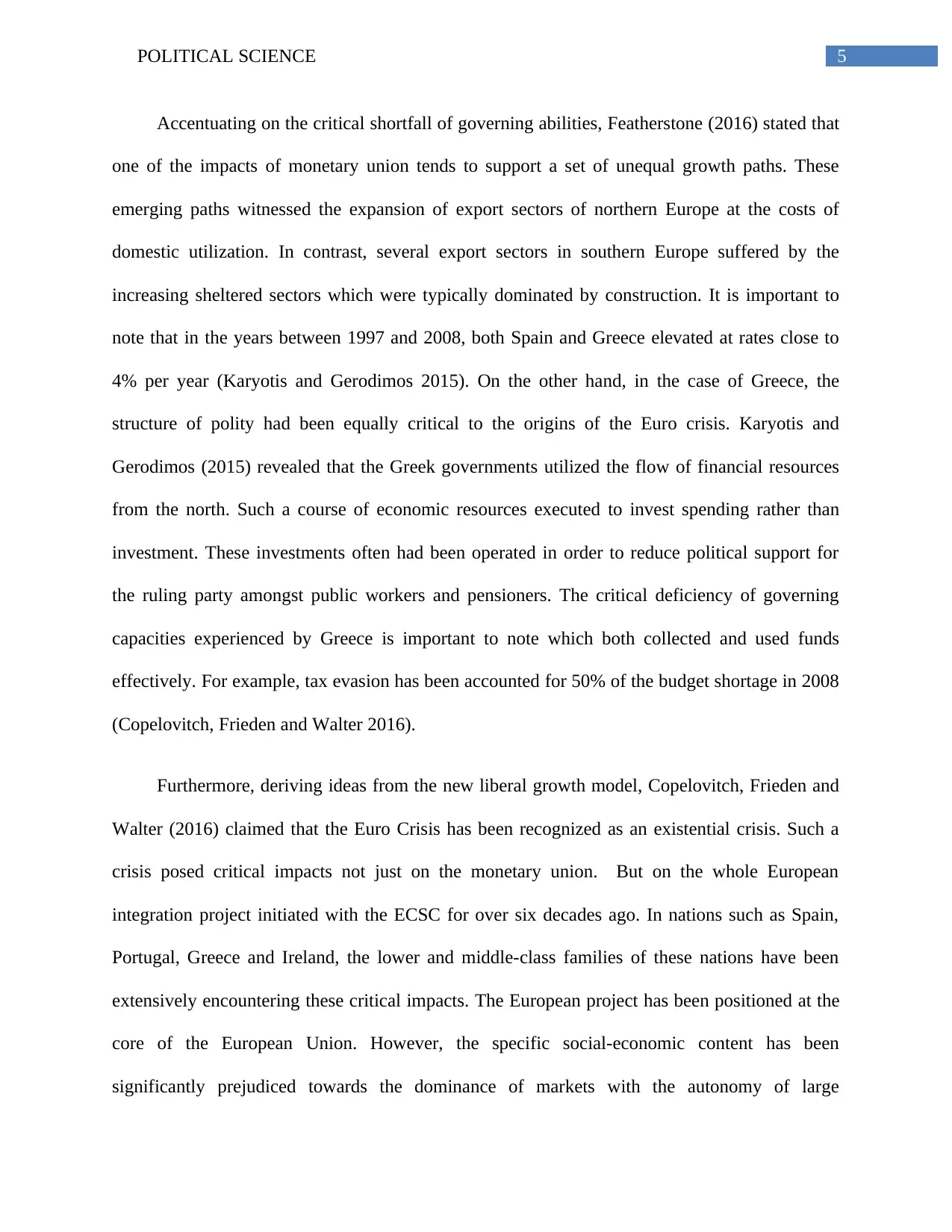
5POLITICAL SCIENCE
Accentuating on the critical shortfall of governing abilities, Featherstone (2016) stated that
one of the impacts of monetary union tends to support a set of unequal growth paths. These
emerging paths witnessed the expansion of export sectors of northern Europe at the costs of
domestic utilization. In contrast, several export sectors in southern Europe suffered by the
increasing sheltered sectors which were typically dominated by construction. It is important to
note that in the years between 1997 and 2008, both Spain and Greece elevated at rates close to
4% per year (Karyotis and Gerodimos 2015). On the other hand, in the case of Greece, the
structure of polity had been equally critical to the origins of the Euro crisis. Karyotis and
Gerodimos (2015) revealed that the Greek governments utilized the flow of financial resources
from the north. Such a course of economic resources executed to invest spending rather than
investment. These investments often had been operated in order to reduce political support for
the ruling party amongst public workers and pensioners. The critical deficiency of governing
capacities experienced by Greece is important to note which both collected and used funds
effectively. For example, tax evasion has been accounted for 50% of the budget shortage in 2008
(Copelovitch, Frieden and Walter 2016).
Furthermore, deriving ideas from the new liberal growth model, Copelovitch, Frieden and
Walter (2016) claimed that the Euro Crisis has been recognized as an existential crisis. Such a
crisis posed critical impacts not just on the monetary union. But on the whole European
integration project initiated with the ECSC for over six decades ago. In nations such as Spain,
Portugal, Greece and Ireland, the lower and middle-class families of these nations have been
extensively encountering these critical impacts. The European project has been positioned at the
core of the European Union. However, the specific social-economic content has been
significantly prejudiced towards the dominance of markets with the autonomy of large
Accentuating on the critical shortfall of governing abilities, Featherstone (2016) stated that
one of the impacts of monetary union tends to support a set of unequal growth paths. These
emerging paths witnessed the expansion of export sectors of northern Europe at the costs of
domestic utilization. In contrast, several export sectors in southern Europe suffered by the
increasing sheltered sectors which were typically dominated by construction. It is important to
note that in the years between 1997 and 2008, both Spain and Greece elevated at rates close to
4% per year (Karyotis and Gerodimos 2015). On the other hand, in the case of Greece, the
structure of polity had been equally critical to the origins of the Euro crisis. Karyotis and
Gerodimos (2015) revealed that the Greek governments utilized the flow of financial resources
from the north. Such a course of economic resources executed to invest spending rather than
investment. These investments often had been operated in order to reduce political support for
the ruling party amongst public workers and pensioners. The critical deficiency of governing
capacities experienced by Greece is important to note which both collected and used funds
effectively. For example, tax evasion has been accounted for 50% of the budget shortage in 2008
(Copelovitch, Frieden and Walter 2016).
Furthermore, deriving ideas from the new liberal growth model, Copelovitch, Frieden and
Walter (2016) claimed that the Euro Crisis has been recognized as an existential crisis. Such a
crisis posed critical impacts not just on the monetary union. But on the whole European
integration project initiated with the ECSC for over six decades ago. In nations such as Spain,
Portugal, Greece and Ireland, the lower and middle-class families of these nations have been
extensively encountering these critical impacts. The European project has been positioned at the
core of the European Union. However, the specific social-economic content has been
significantly prejudiced towards the dominance of markets with the autonomy of large
⊘ This is a preview!⊘
Do you want full access?
Subscribe today to unlock all pages.

Trusted by 1+ million students worldwide
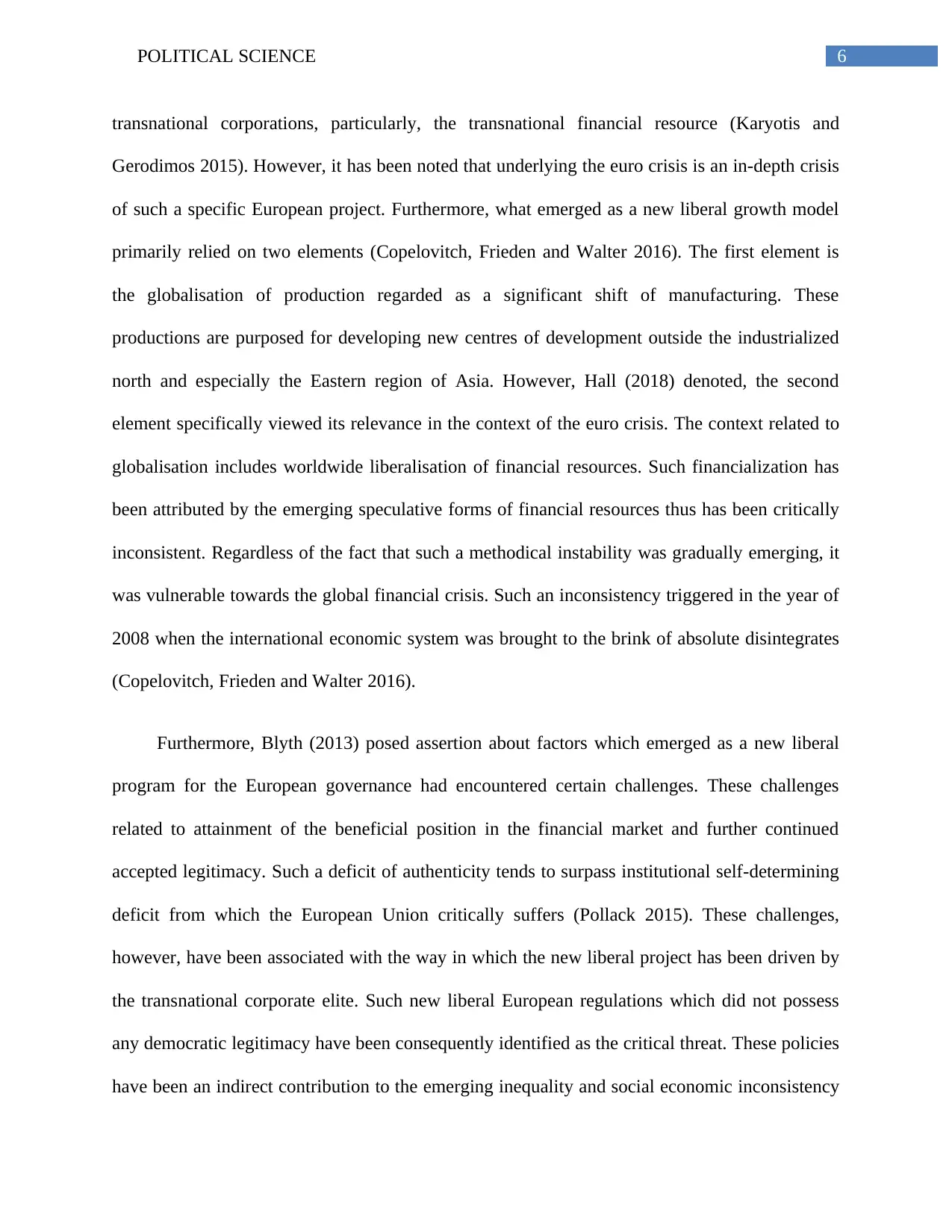
6POLITICAL SCIENCE
transnational corporations, particularly, the transnational financial resource (Karyotis and
Gerodimos 2015). However, it has been noted that underlying the euro crisis is an in-depth crisis
of such a specific European project. Furthermore, what emerged as a new liberal growth model
primarily relied on two elements (Copelovitch, Frieden and Walter 2016). The first element is
the globalisation of production regarded as a significant shift of manufacturing. These
productions are purposed for developing new centres of development outside the industrialized
north and especially the Eastern region of Asia. However, Hall (2018) denoted, the second
element specifically viewed its relevance in the context of the euro crisis. The context related to
globalisation includes worldwide liberalisation of financial resources. Such financialization has
been attributed by the emerging speculative forms of financial resources thus has been critically
inconsistent. Regardless of the fact that such a methodical instability was gradually emerging, it
was vulnerable towards the global financial crisis. Such an inconsistency triggered in the year of
2008 when the international economic system was brought to the brink of absolute disintegrates
(Copelovitch, Frieden and Walter 2016).
Furthermore, Blyth (2013) posed assertion about factors which emerged as a new liberal
program for the European governance had encountered certain challenges. These challenges
related to attainment of the beneficial position in the financial market and further continued
accepted legitimacy. Such a deficit of authenticity tends to surpass institutional self-determining
deficit from which the European Union critically suffers (Pollack 2015). These challenges,
however, have been associated with the way in which the new liberal project has been driven by
the transnational corporate elite. Such new liberal European regulations which did not possess
any democratic legitimacy have been consequently identified as the critical threat. These policies
have been an indirect contribution to the emerging inequality and social economic inconsistency
transnational corporations, particularly, the transnational financial resource (Karyotis and
Gerodimos 2015). However, it has been noted that underlying the euro crisis is an in-depth crisis
of such a specific European project. Furthermore, what emerged as a new liberal growth model
primarily relied on two elements (Copelovitch, Frieden and Walter 2016). The first element is
the globalisation of production regarded as a significant shift of manufacturing. These
productions are purposed for developing new centres of development outside the industrialized
north and especially the Eastern region of Asia. However, Hall (2018) denoted, the second
element specifically viewed its relevance in the context of the euro crisis. The context related to
globalisation includes worldwide liberalisation of financial resources. Such financialization has
been attributed by the emerging speculative forms of financial resources thus has been critically
inconsistent. Regardless of the fact that such a methodical instability was gradually emerging, it
was vulnerable towards the global financial crisis. Such an inconsistency triggered in the year of
2008 when the international economic system was brought to the brink of absolute disintegrates
(Copelovitch, Frieden and Walter 2016).
Furthermore, Blyth (2013) posed assertion about factors which emerged as a new liberal
program for the European governance had encountered certain challenges. These challenges
related to attainment of the beneficial position in the financial market and further continued
accepted legitimacy. Such a deficit of authenticity tends to surpass institutional self-determining
deficit from which the European Union critically suffers (Pollack 2015). These challenges,
however, have been associated with the way in which the new liberal project has been driven by
the transnational corporate elite. Such new liberal European regulations which did not possess
any democratic legitimacy have been consequently identified as the critical threat. These policies
have been an indirect contribution to the emerging inequality and social economic inconsistency
Paraphrase This Document
Need a fresh take? Get an instant paraphrase of this document with our AI Paraphraser
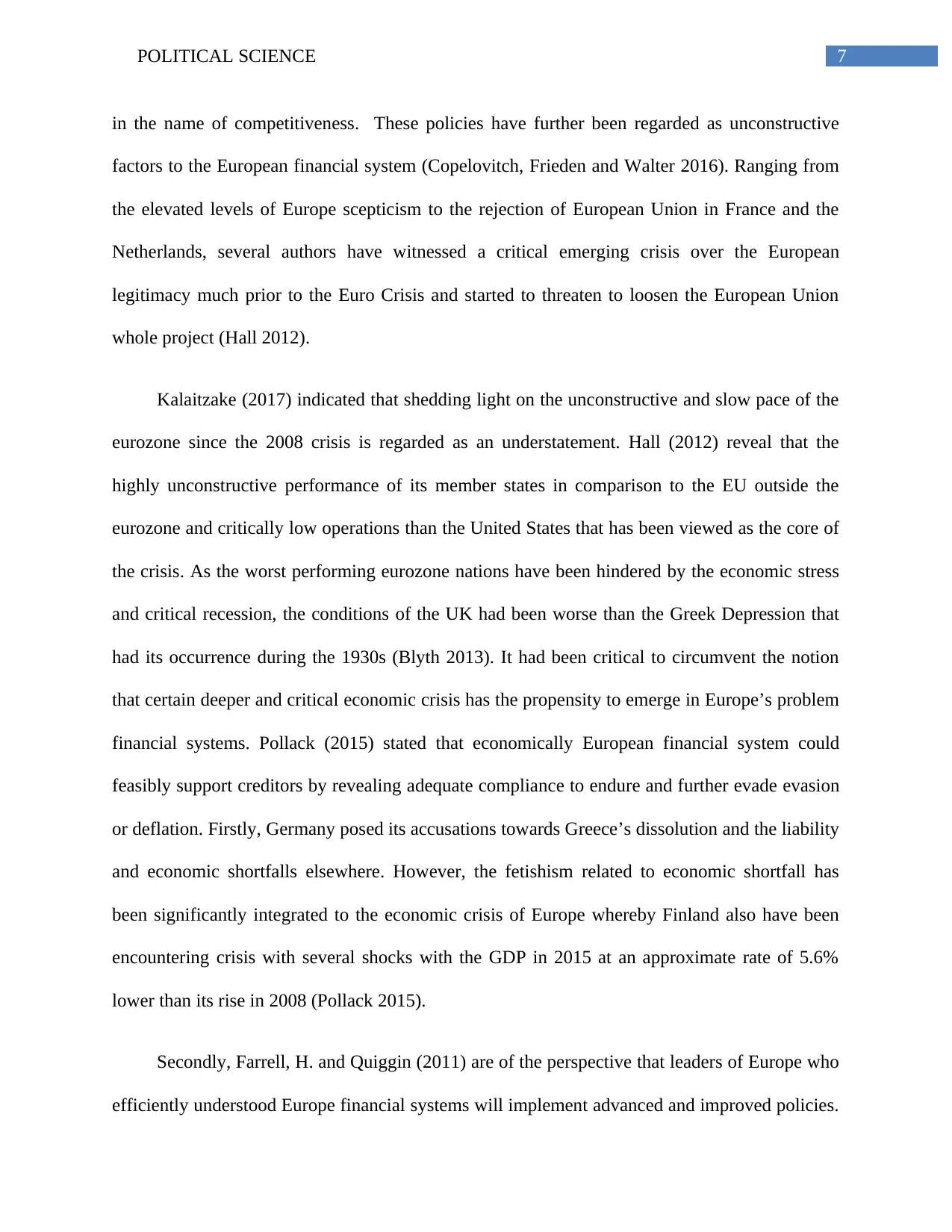
7POLITICAL SCIENCE
in the name of competitiveness. These policies have further been regarded as unconstructive
factors to the European financial system (Copelovitch, Frieden and Walter 2016). Ranging from
the elevated levels of Europe scepticism to the rejection of European Union in France and the
Netherlands, several authors have witnessed a critical emerging crisis over the European
legitimacy much prior to the Euro Crisis and started to threaten to loosen the European Union
whole project (Hall 2012).
Kalaitzake (2017) indicated that shedding light on the unconstructive and slow pace of the
eurozone since the 2008 crisis is regarded as an understatement. Hall (2012) reveal that the
highly unconstructive performance of its member states in comparison to the EU outside the
eurozone and critically low operations than the United States that has been viewed as the core of
the crisis. As the worst performing eurozone nations have been hindered by the economic stress
and critical recession, the conditions of the UK had been worse than the Greek Depression that
had its occurrence during the 1930s (Blyth 2013). It had been critical to circumvent the notion
that certain deeper and critical economic crisis has the propensity to emerge in Europe’s problem
financial systems. Pollack (2015) stated that economically European financial system could
feasibly support creditors by revealing adequate compliance to endure and further evade evasion
or deflation. Firstly, Germany posed its accusations towards Greece’s dissolution and the liability
and economic shortfalls elsewhere. However, the fetishism related to economic shortfall has
been significantly integrated to the economic crisis of Europe whereby Finland also have been
encountering crisis with several shocks with the GDP in 2015 at an approximate rate of 5.6%
lower than its rise in 2008 (Pollack 2015).
Secondly, Farrell, H. and Quiggin (2011) are of the perspective that leaders of Europe who
efficiently understood Europe financial systems will implement advanced and improved policies.
in the name of competitiveness. These policies have further been regarded as unconstructive
factors to the European financial system (Copelovitch, Frieden and Walter 2016). Ranging from
the elevated levels of Europe scepticism to the rejection of European Union in France and the
Netherlands, several authors have witnessed a critical emerging crisis over the European
legitimacy much prior to the Euro Crisis and started to threaten to loosen the European Union
whole project (Hall 2012).
Kalaitzake (2017) indicated that shedding light on the unconstructive and slow pace of the
eurozone since the 2008 crisis is regarded as an understatement. Hall (2012) reveal that the
highly unconstructive performance of its member states in comparison to the EU outside the
eurozone and critically low operations than the United States that has been viewed as the core of
the crisis. As the worst performing eurozone nations have been hindered by the economic stress
and critical recession, the conditions of the UK had been worse than the Greek Depression that
had its occurrence during the 1930s (Blyth 2013). It had been critical to circumvent the notion
that certain deeper and critical economic crisis has the propensity to emerge in Europe’s problem
financial systems. Pollack (2015) stated that economically European financial system could
feasibly support creditors by revealing adequate compliance to endure and further evade evasion
or deflation. Firstly, Germany posed its accusations towards Greece’s dissolution and the liability
and economic shortfalls elsewhere. However, the fetishism related to economic shortfall has
been significantly integrated to the economic crisis of Europe whereby Finland also have been
encountering crisis with several shocks with the GDP in 2015 at an approximate rate of 5.6%
lower than its rise in 2008 (Pollack 2015).
Secondly, Farrell, H. and Quiggin (2011) are of the perspective that leaders of Europe who
efficiently understood Europe financial systems will implement advanced and improved policies.
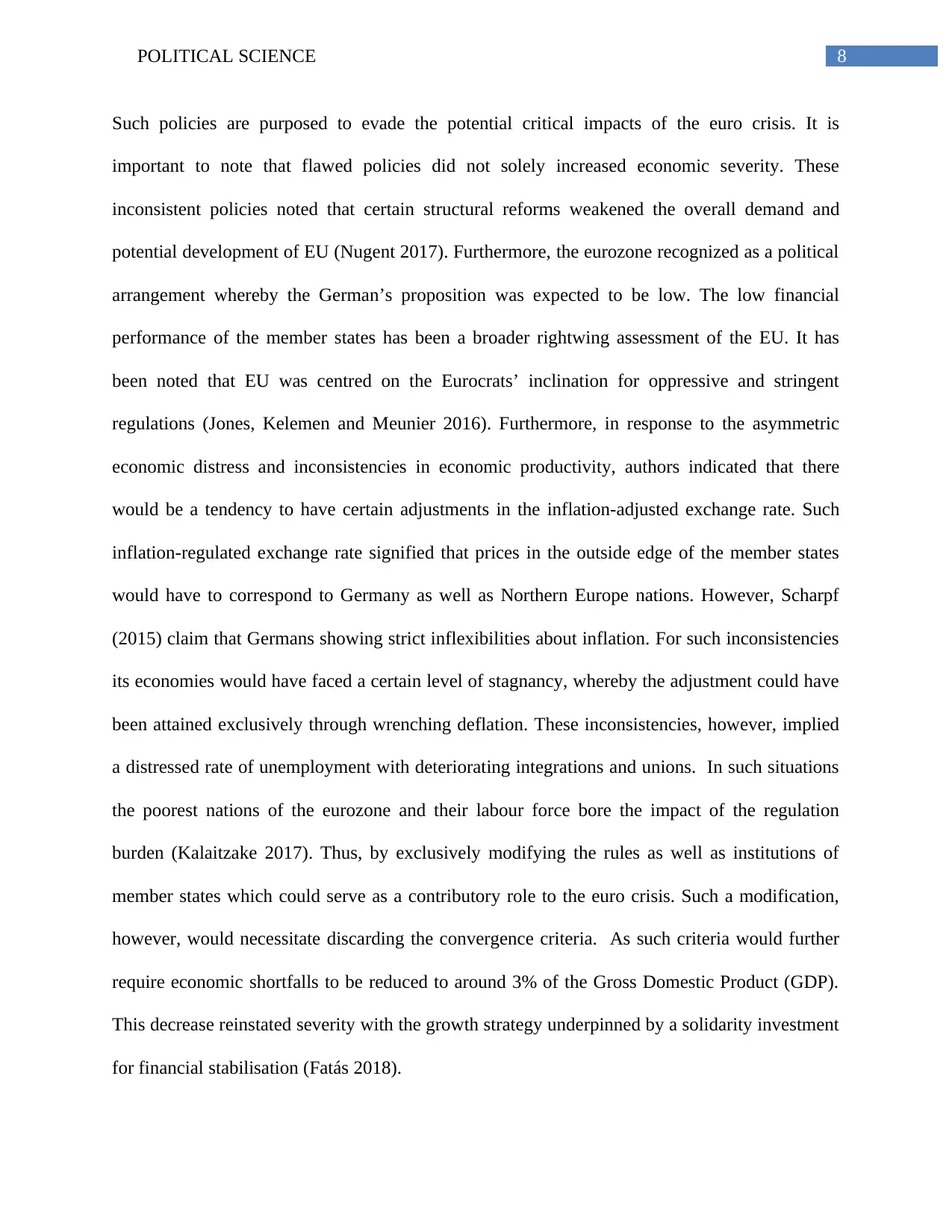
8POLITICAL SCIENCE
Such policies are purposed to evade the potential critical impacts of the euro crisis. It is
important to note that flawed policies did not solely increased economic severity. These
inconsistent policies noted that certain structural reforms weakened the overall demand and
potential development of EU (Nugent 2017). Furthermore, the eurozone recognized as a political
arrangement whereby the German’s proposition was expected to be low. The low financial
performance of the member states has been a broader rightwing assessment of the EU. It has
been noted that EU was centred on the Eurocrats’ inclination for oppressive and stringent
regulations (Jones, Kelemen and Meunier 2016). Furthermore, in response to the asymmetric
economic distress and inconsistencies in economic productivity, authors indicated that there
would be a tendency to have certain adjustments in the inflation-adjusted exchange rate. Such
inflation-regulated exchange rate signified that prices in the outside edge of the member states
would have to correspond to Germany as well as Northern Europe nations. However, Scharpf
(2015) claim that Germans showing strict inflexibilities about inflation. For such inconsistencies
its economies would have faced a certain level of stagnancy, whereby the adjustment could have
been attained exclusively through wrenching deflation. These inconsistencies, however, implied
a distressed rate of unemployment with deteriorating integrations and unions. In such situations
the poorest nations of the eurozone and their labour force bore the impact of the regulation
burden (Kalaitzake 2017). Thus, by exclusively modifying the rules as well as institutions of
member states which could serve as a contributory role to the euro crisis. Such a modification,
however, would necessitate discarding the convergence criteria. As such criteria would further
require economic shortfalls to be reduced to around 3% of the Gross Domestic Product (GDP).
This decrease reinstated severity with the growth strategy underpinned by a solidarity investment
for financial stabilisation (Fatás 2018).
Such policies are purposed to evade the potential critical impacts of the euro crisis. It is
important to note that flawed policies did not solely increased economic severity. These
inconsistent policies noted that certain structural reforms weakened the overall demand and
potential development of EU (Nugent 2017). Furthermore, the eurozone recognized as a political
arrangement whereby the German’s proposition was expected to be low. The low financial
performance of the member states has been a broader rightwing assessment of the EU. It has
been noted that EU was centred on the Eurocrats’ inclination for oppressive and stringent
regulations (Jones, Kelemen and Meunier 2016). Furthermore, in response to the asymmetric
economic distress and inconsistencies in economic productivity, authors indicated that there
would be a tendency to have certain adjustments in the inflation-adjusted exchange rate. Such
inflation-regulated exchange rate signified that prices in the outside edge of the member states
would have to correspond to Germany as well as Northern Europe nations. However, Scharpf
(2015) claim that Germans showing strict inflexibilities about inflation. For such inconsistencies
its economies would have faced a certain level of stagnancy, whereby the adjustment could have
been attained exclusively through wrenching deflation. These inconsistencies, however, implied
a distressed rate of unemployment with deteriorating integrations and unions. In such situations
the poorest nations of the eurozone and their labour force bore the impact of the regulation
burden (Kalaitzake 2017). Thus, by exclusively modifying the rules as well as institutions of
member states which could serve as a contributory role to the euro crisis. Such a modification,
however, would necessitate discarding the convergence criteria. As such criteria would further
require economic shortfalls to be reduced to around 3% of the Gross Domestic Product (GDP).
This decrease reinstated severity with the growth strategy underpinned by a solidarity investment
for financial stabilisation (Fatás 2018).
⊘ This is a preview!⊘
Do you want full access?
Subscribe today to unlock all pages.

Trusted by 1+ million students worldwide
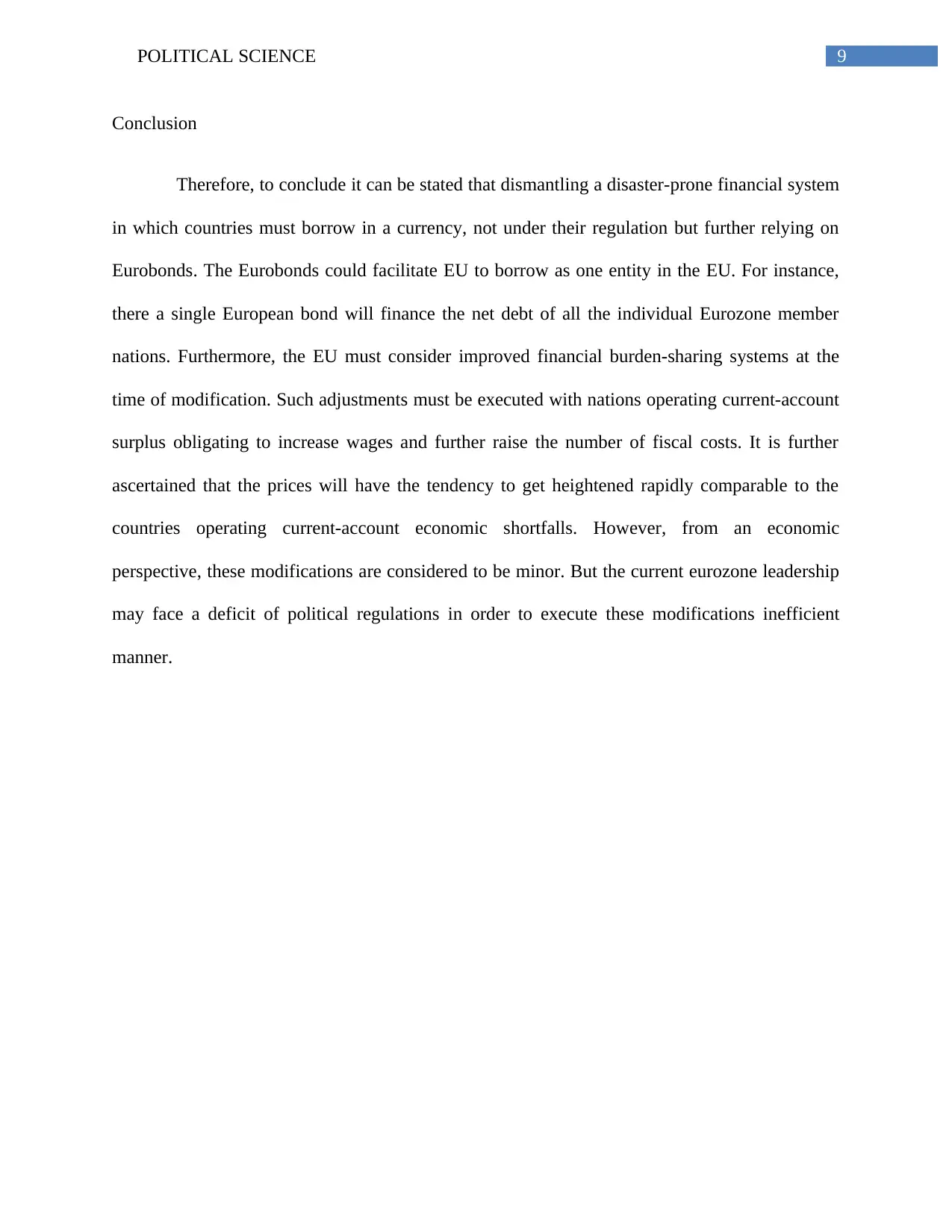
9POLITICAL SCIENCE
Conclusion
Therefore, to conclude it can be stated that dismantling a disaster-prone financial system
in which countries must borrow in a currency, not under their regulation but further relying on
Eurobonds. The Eurobonds could facilitate EU to borrow as one entity in the EU. For instance,
there a single European bond will finance the net debt of all the individual Eurozone member
nations. Furthermore, the EU must consider improved financial burden-sharing systems at the
time of modification. Such adjustments must be executed with nations operating current-account
surplus obligating to increase wages and further raise the number of fiscal costs. It is further
ascertained that the prices will have the tendency to get heightened rapidly comparable to the
countries operating current-account economic shortfalls. However, from an economic
perspective, these modifications are considered to be minor. But the current eurozone leadership
may face a deficit of political regulations in order to execute these modifications inefficient
manner.
Conclusion
Therefore, to conclude it can be stated that dismantling a disaster-prone financial system
in which countries must borrow in a currency, not under their regulation but further relying on
Eurobonds. The Eurobonds could facilitate EU to borrow as one entity in the EU. For instance,
there a single European bond will finance the net debt of all the individual Eurozone member
nations. Furthermore, the EU must consider improved financial burden-sharing systems at the
time of modification. Such adjustments must be executed with nations operating current-account
surplus obligating to increase wages and further raise the number of fiscal costs. It is further
ascertained that the prices will have the tendency to get heightened rapidly comparable to the
countries operating current-account economic shortfalls. However, from an economic
perspective, these modifications are considered to be minor. But the current eurozone leadership
may face a deficit of political regulations in order to execute these modifications inefficient
manner.
Paraphrase This Document
Need a fresh take? Get an instant paraphrase of this document with our AI Paraphraser
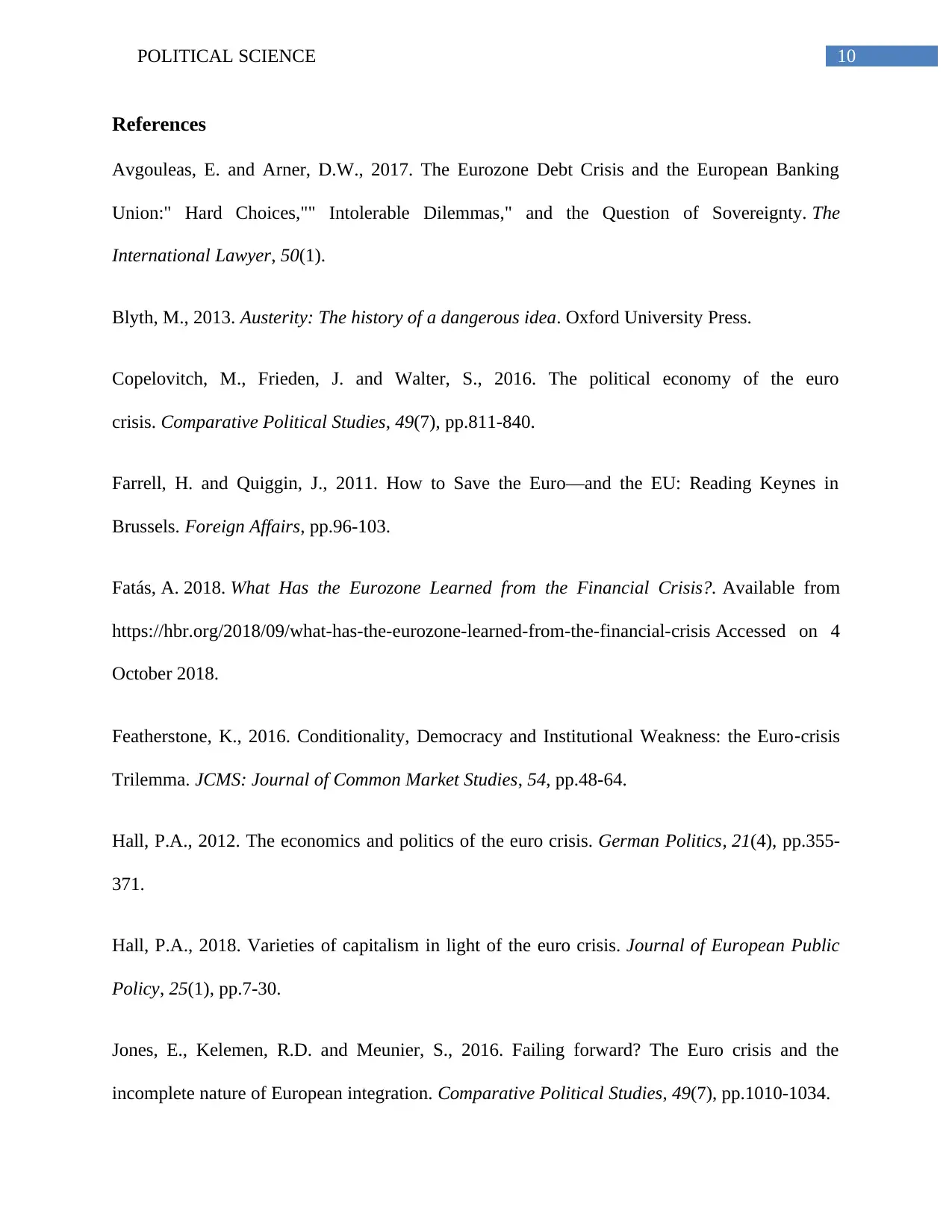
10POLITICAL SCIENCE
References
Avgouleas, E. and Arner, D.W., 2017. The Eurozone Debt Crisis and the European Banking
Union:" Hard Choices,"" Intolerable Dilemmas," and the Question of Sovereignty. The
International Lawyer, 50(1).
Blyth, M., 2013. Austerity: The history of a dangerous idea. Oxford University Press.
Copelovitch, M., Frieden, J. and Walter, S., 2016. The political economy of the euro
crisis. Comparative Political Studies, 49(7), pp.811-840.
Farrell, H. and Quiggin, J., 2011. How to Save the Euro—and the EU: Reading Keynes in
Brussels. Foreign Affairs, pp.96-103.
Fatás, A. 2018. What Has the Eurozone Learned from the Financial Crisis?. Available from
https://hbr.org/2018/09/what-has-the-eurozone-learned-from-the-financial-crisis Accessed on 4
October 2018.
Featherstone, K., 2016. Conditionality, Democracy and Institutional Weakness: the Euro‐crisis
Trilemma. JCMS: Journal of Common Market Studies, 54, pp.48-64.
Hall, P.A., 2012. The economics and politics of the euro crisis. German Politics, 21(4), pp.355-
371.
Hall, P.A., 2018. Varieties of capitalism in light of the euro crisis. Journal of European Public
Policy, 25(1), pp.7-30.
Jones, E., Kelemen, R.D. and Meunier, S., 2016. Failing forward? The Euro crisis and the
incomplete nature of European integration. Comparative Political Studies, 49(7), pp.1010-1034.
References
Avgouleas, E. and Arner, D.W., 2017. The Eurozone Debt Crisis and the European Banking
Union:" Hard Choices,"" Intolerable Dilemmas," and the Question of Sovereignty. The
International Lawyer, 50(1).
Blyth, M., 2013. Austerity: The history of a dangerous idea. Oxford University Press.
Copelovitch, M., Frieden, J. and Walter, S., 2016. The political economy of the euro
crisis. Comparative Political Studies, 49(7), pp.811-840.
Farrell, H. and Quiggin, J., 2011. How to Save the Euro—and the EU: Reading Keynes in
Brussels. Foreign Affairs, pp.96-103.
Fatás, A. 2018. What Has the Eurozone Learned from the Financial Crisis?. Available from
https://hbr.org/2018/09/what-has-the-eurozone-learned-from-the-financial-crisis Accessed on 4
October 2018.
Featherstone, K., 2016. Conditionality, Democracy and Institutional Weakness: the Euro‐crisis
Trilemma. JCMS: Journal of Common Market Studies, 54, pp.48-64.
Hall, P.A., 2012. The economics and politics of the euro crisis. German Politics, 21(4), pp.355-
371.
Hall, P.A., 2018. Varieties of capitalism in light of the euro crisis. Journal of European Public
Policy, 25(1), pp.7-30.
Jones, E., Kelemen, R.D. and Meunier, S., 2016. Failing forward? The Euro crisis and the
incomplete nature of European integration. Comparative Political Studies, 49(7), pp.1010-1034.
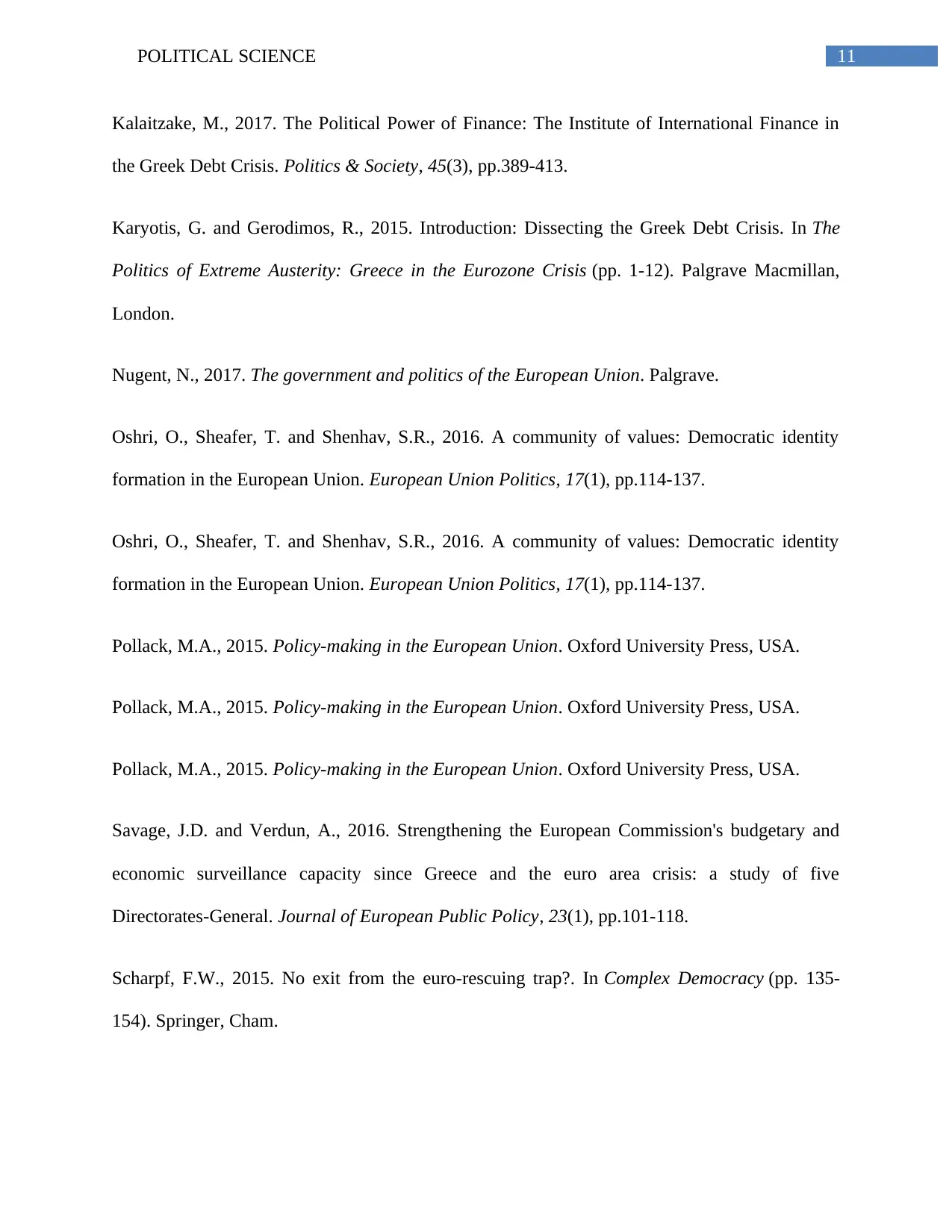
11POLITICAL SCIENCE
Kalaitzake, M., 2017. The Political Power of Finance: The Institute of International Finance in
the Greek Debt Crisis. Politics & Society, 45(3), pp.389-413.
Karyotis, G. and Gerodimos, R., 2015. Introduction: Dissecting the Greek Debt Crisis. In The
Politics of Extreme Austerity: Greece in the Eurozone Crisis (pp. 1-12). Palgrave Macmillan,
London.
Nugent, N., 2017. The government and politics of the European Union. Palgrave.
Oshri, O., Sheafer, T. and Shenhav, S.R., 2016. A community of values: Democratic identity
formation in the European Union. European Union Politics, 17(1), pp.114-137.
Oshri, O., Sheafer, T. and Shenhav, S.R., 2016. A community of values: Democratic identity
formation in the European Union. European Union Politics, 17(1), pp.114-137.
Pollack, M.A., 2015. Policy-making in the European Union. Oxford University Press, USA.
Pollack, M.A., 2015. Policy-making in the European Union. Oxford University Press, USA.
Pollack, M.A., 2015. Policy-making in the European Union. Oxford University Press, USA.
Savage, J.D. and Verdun, A., 2016. Strengthening the European Commission's budgetary and
economic surveillance capacity since Greece and the euro area crisis: a study of five
Directorates-General. Journal of European Public Policy, 23(1), pp.101-118.
Scharpf, F.W., 2015. No exit from the euro-rescuing trap?. In Complex Democracy (pp. 135-
154). Springer, Cham.
Kalaitzake, M., 2017. The Political Power of Finance: The Institute of International Finance in
the Greek Debt Crisis. Politics & Society, 45(3), pp.389-413.
Karyotis, G. and Gerodimos, R., 2015. Introduction: Dissecting the Greek Debt Crisis. In The
Politics of Extreme Austerity: Greece in the Eurozone Crisis (pp. 1-12). Palgrave Macmillan,
London.
Nugent, N., 2017. The government and politics of the European Union. Palgrave.
Oshri, O., Sheafer, T. and Shenhav, S.R., 2016. A community of values: Democratic identity
formation in the European Union. European Union Politics, 17(1), pp.114-137.
Oshri, O., Sheafer, T. and Shenhav, S.R., 2016. A community of values: Democratic identity
formation in the European Union. European Union Politics, 17(1), pp.114-137.
Pollack, M.A., 2015. Policy-making in the European Union. Oxford University Press, USA.
Pollack, M.A., 2015. Policy-making in the European Union. Oxford University Press, USA.
Pollack, M.A., 2015. Policy-making in the European Union. Oxford University Press, USA.
Savage, J.D. and Verdun, A., 2016. Strengthening the European Commission's budgetary and
economic surveillance capacity since Greece and the euro area crisis: a study of five
Directorates-General. Journal of European Public Policy, 23(1), pp.101-118.
Scharpf, F.W., 2015. No exit from the euro-rescuing trap?. In Complex Democracy (pp. 135-
154). Springer, Cham.
⊘ This is a preview!⊘
Do you want full access?
Subscribe today to unlock all pages.

Trusted by 1+ million students worldwide
1 out of 13
Related Documents
Your All-in-One AI-Powered Toolkit for Academic Success.
+13062052269
info@desklib.com
Available 24*7 on WhatsApp / Email
![[object Object]](/_next/static/media/star-bottom.7253800d.svg)
Unlock your academic potential
Copyright © 2020–2025 A2Z Services. All Rights Reserved. Developed and managed by ZUCOL.





